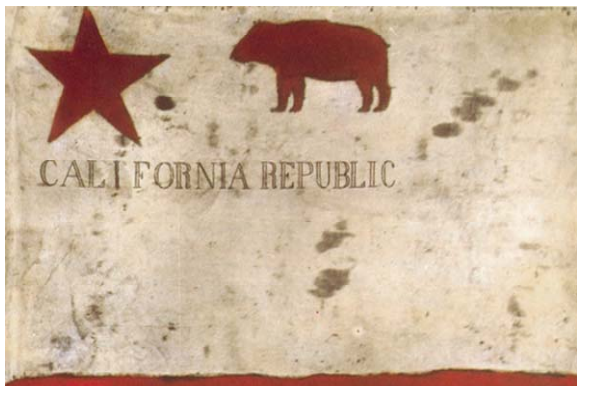* Before I start on my latest gleanings related to my recent reading of Richard Henry Dana's Two Years Before the Mast, I am once again going to comment on the Bear Flag, designed (supposedly, there has been some contention) by William Todd, a nephew of Abraham Lincoln's wife, Mary Todd. One thing to remember is that this flag is hand painted by someone, and when viewing a good reproduction of the flag flown over Sonoma during the Bear Flag Revolt (1846) you can still see the guide lines for the letters and the star. That doesn't stop me from failing to see "bear" and instead seeing "boar" in the outline of the animal on the flag. It does, however, remind me that the tools at hand during different periods in history are very different from the present.
* One of the reasons I read Two Years... was because it was recommended to me by a guest at Petaluma Adobe SHP. During the discussion he also mentioned that Dana Point was "founded" by the author's father. That turns out not to be the case. According to the Dana Point Chamber of Commerce website page on the history of Dana Point, Dana Point, was founded by developer Sidney H. Woodruff, who is famous for the Hollywood development advertised in the iconic sign. It was named for Richard Henry Dana himself, who, in his book, referred to what is now the headlands at Dana Point as the "only romantic spot on the California Coast".
but back to Dana and Vallejo...
Early in the book, as published in 1840, Dana describes Guadalupe Vallejo as "the most popular, among the Americans and English, of any man in California" and "being suspected of being favorably inclined to foreigners." Dana's memoire takes place during 1835-1836, which corresponds to the time the rancho at Petaluma was built, following the secularization order which sent him from San Francisco in 1834 to take over the assets of the mission in Sonoma. His original land grant was 44,000 acres, and was granted an additional 22,000. The adobe building that became the center of Vallejo's ranching operation would just have begun construction during the time Dana was there, and it had not been completed by the time Vallejo was taken captive by the Bear Flaggers in '46.
The above image, from the Online Archive of California, shows the land grant of Vallejo's lands as confirmed by the US Government in 1860. This grant verifies his right to the lands he gained during secularization (44,000 acres), as well as his own 22,000 land grant from the Mexican Government. There are other writings, not official writings of any sort, but letters and memoires of various sorts which say that Vallejo had other lands, gotten under less than legal means, which had been placed in the names of his family and friends, and could not be recovered by Vallejo in US courts when the Americans were sorting out land ownership. His land stretched from the Petaluma River to Sonoma Creek.
This is consistent with Dana's later description of Vallejo in an addendum to his book, which was added 25 years later when he returned to California in 1859 and once again met Vallejo: "I learned that the two Vallejos, Guadalupe and Salvador, owned, at an early time, nearly all Napa and Sonoma, having princely estates." The county lines were set in 1850, during the time when the US was dealing with these issues of land grants. "nearly all of Sonoma and Napa", is much MUCH more than the 66,662 acres left to the rancho following the US issuance of the land grants.
Dana does not attribute the fall of Vallejo's fortune to the loss of land, however, as he does the investment placed in an agreement with the US Government would place the Capitol at the City of Vallejo, near Mare Island, where they had already built a Navy Yard. According to Dana, they spent $100,000 on buildings for the Capitol, which was moved to Vallejo for two years, then to San Jose on a new contract.


Comments
Post a Comment